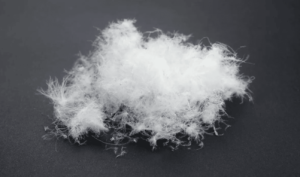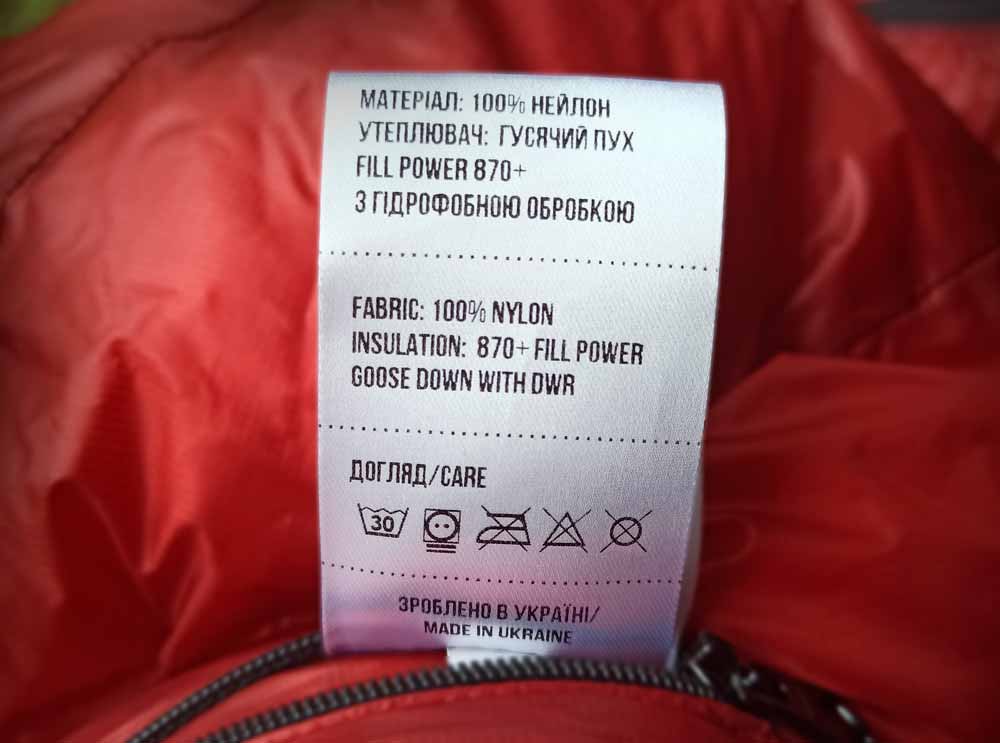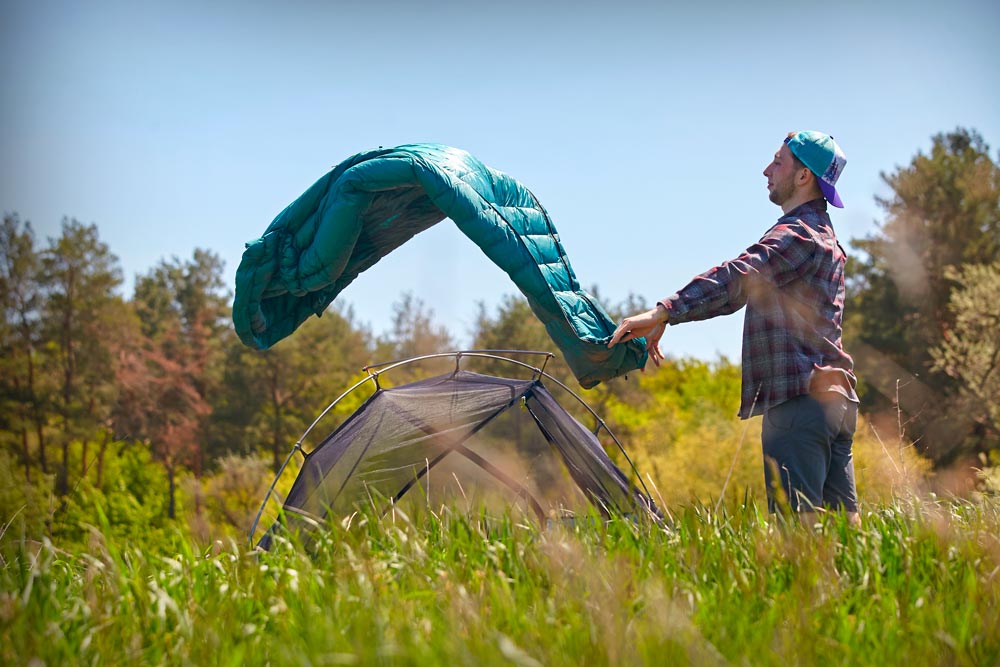Care instructions: How to wash, dry and storage your down sleeping bag or quilt
When you buy an important item for hiking, such as a down sleeping bag or quilt, you are thinking about how long it will serve. In this article, we’ll tell you how to maximize the life of your sleeping bag without losing its warming properties.

A down quilt or sleeping bag needs special care. Before filling the sleeping bag the down is treated with a special water-repellent agent that allows your sleeping bag staying dry from body evaporation or condensation in the tent.
You should wash your down sleeping bag only in the following cases:
- If you cannot remove the stain or dirt with easier methods, such as cleaning with a cloth, wet towel, or hand washing a separate section of the product.
- If you start to notice that the sleeping bag is losing its properties (the down does not fluff up as it used to – it’s stuck together, clumped up. Or if the sleeping bag has absorbed unpleasant odors)
So, how to extend the life of a sleeping bag without losing its properties?
Storing down sleeping bag at home
- Most of the time, sleeping bags are usually kept in a wardrobe, and the conditions in which they are stored can have a big impact on their service life.You should dry your sleeping bag completely before putting it in a wardrobe for long-term storage.
- Never store the sleeping bag in a compressed state for a long time. The structure of the down loses its elasticity and excessive compression during prolonged storage in a compression sack. Sleeping bags or quilts should be stored in a relaxed state, for example, in a bulky mesh bag.
- We recommend taking the sleeping bag out of the storage bag once a month and folding it in a new way, or at least just turning it over. This will allow the down below to restore its maximum volume.
How to take care of a down sleeping bag while hiking?
During a trip, a sleeping bag is exposed to even more risks than during storage. However, it’s easy to avoid.
- After night in a tent, the sleeping bag absorbs moisture, so you should dry it in the morning if it’s possible. If you don’t, moisture will accumulate in the sleeping bag, making the down less fluffy.
- One of the causes of contamination is the sweating of our skin. With our sweat, various fats and other substances get onto the fabric and into insulation, making the down clump together. It can reduce the thermal insulation properties of the sleeping bag. There are two ways to avoid this – sleep in clothes or in a special liner for your sleeping bag. These methods will not only extend the service life, but also become simple personal hygiene measures.
- Keep your sleeping bag away from sparks and fire. Fabrics used to make modern sleeping bags are very afraid of fire. The slightest spark from a fire can lead to irreparable consequences for the sleeping bag and even a threat to your life. So always keep safety in mind.
How to wash a down sleeping bag?
The best time to wash your sleeping bag is the end of the season, before you put it in the wardrobe.

First of all, you should carefully study the product label for care and washing instructions. There are 2 ways to wash a sleeping bag – by hand and in a machine.
In both cases, you should use special detergents for down. We recommend using such products as Grangers Down Wash or Nikwax Down Wash. The amount of detergent for one wash is indicated on the package.
Machine washing
- We recommend soaking the down sleeping bag before washing. The easiest way to do this is to put it in a bathtub filled with water or another container and use your hands to sink it in the water. It will prevent the effect when the down floats inside the cells of the sleeping bag (because it is treated with DWR). However, do not soak the sleeping bag for more than half an hour.
- Afterwards, put the sleeping bag in a horizontal-loading washing machine. Vertical-loading machines have a drum structure that can damage the thin fabric.
- Add special soap in the amount indicated on the bottle.
- Wash in a delicate cycle at the temperature indicated on the label of your sleeping bag.
- Spin at the lowest possible speed.
- If the sleeping bag is still soapy or super wet, repeat the wash, but without the soap.
Hand washing
- Fill a bathtub or other large container with warm water and add special soap.
- Place the sleeping bag in it and keep it under water until it is soaked.
- Wash the most soiled areas thoroughly and leave the sleeping bag to soak for another half hour.
- Drain the water and gently wring out the sleeping bag without twisting it.
- Fill with clean rinse water and leave for 15 minutes, then rinse the sleeping bag.
- Repeat steps 4 and 5 until the drained water is free of detergents.
- After the final spin, you can proceed to drying.
How to dry a down sleeping bag?
There are two ways to dry your sleeping bag, just like washing it – in a dryer or by yourself.

In the dryer
To dry your sleeping bag in the dryer, you need to take one important point into account. At the moment when the sleeping bag is almost dry, the down begins to straighten and the sleeping bag takes up the entire volume of the dryer and does not allow hot air to circulate. It can lead to overheating and the synthetic fabric can become melted. Therefore, you should use a large capacity dryer. If you don’t have one, you should follow the next steps:
- Set the dryer to the lowest temperature, time 30 minutes. It is advisable to place special rubber balls in the dryer drum, which can be included with down cleaning products, as well as tennis balls.
- Take out the sleeping bag, turn it out, fluff up the down with your hands.
- Repeat the full 30-minute cycle.
- After the second half-hour cycle, the down will begin to fluff up, which can make the dryer overheat. To avoid this, just carefully touch the inspection window of the dryer by hand. If touching it does not cause discomfort, you can continue drying, but if it does, pause the dryer and repeat the steps described in the second paragraph. At first, this may happen every 10-15 minutes. Over time, overheating will increase to 3-5 minutes.
- Depending on the volume of the sleeping bag, the drying takes 1.5-2.5 hours.
- Before you put the sleeping bag in the wardrobe, you should make sure that it is completely dry, because if not, the remaining moisture can lead to an unpleasant smell and even down rot.
Drying by yourself
In general, we do not recommend drying down sleeping bags by hand, but in the absence of a specialized dryer and if necessary, it is possible to do so. You can dry your sleeping bag by hand only in warm weather and at low humidity. Also, we do not recommend manually drying thick and warm down sleeping bags with more than 400g of down. To properly dry a down sleeping bag, follow these rules:
- Lay out the sleeping bag in a horizontal position. If you dry it vertically, the down will clump at the bottom of the cells.
- Every few hours, turn the sleeping bag over and shake it a little.
- If down lumps have appeared, wait for them to dry and gently fluff them up by hand, being careful to avoid damaging the down.
- When the insulation is dry, you should carefully break it up with your hands to spread it evenly over the cells.
- You should carefully make sure that the sleeping bag is completely dry before putting it away for storage, otherwise, any moisture residue can lead to a damp smell and even down rot.
Conclusion
So these are the most important rules for extending the life of your down sleeping bag:
- Store the sleeping bag without compressing it.
- Dry ше before storing.
- Use liners and clothing while sleeping.
- Protect it from fire.
- Do not wash it very often.
- Wash primarily according to the product care instructions on the label.
- Use only specially special down cleaning products.
- Spin and dry properly.